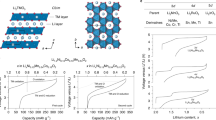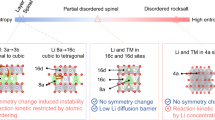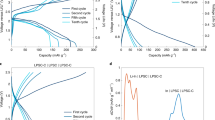Abstract
The commercialization of high-energy batteries with lithium-rich cathode materials exhibiting combined cationic/anionic redox processes awaits the elimination of certain practical bottlenecks. Among these, large voltage hysteresis remains the most obscure from a fundamental thermochemical perspective. Here, we study this issue by directly measuring, via isothermal calorimetry, the heat generated by Li/Li2Ru0.75Sn0.25O3 (Li/LRSO) cells during various cycling conditions, with LRSO being a ‘model’ Li-rich layered cathode. We show how this heat thermodynamically relates to the lost electrical work that is crucial for practical applications. We further reveal that anionic redox on charging and discharging adopts different metastable paths having non-identical enthalpy potentials, such that the overall Li content no longer remains the unique reaction coordinate, unlike in fully path-reversible cationic redox. We elucidate how quasi-static voltage hysteresis is related to heat dissipated due to non-equilibrium entropy production. Overall, this study establishes the great benefits of isothermal calorimetry for enabling energy-efficient electrode materials in next-generation batteries.
This is a preview of subscription content, access via your institution
Access options
Access Nature and 54 other Nature Portfolio journals
Get Nature+, our best-value online-access subscription
$29.99 / 30 days
cancel any time
Subscribe to this journal
Receive 12 digital issues and online access to articles
$119.00 per year
only $9.92 per issue
Buy this article
- Purchase on Springer Link
- Instant access to full article PDF
Prices may be subject to local taxes which are calculated during checkout






Similar content being viewed by others
Data availability
The authors declare that the main data supporting the findings of this study are available within the article and its Supporting Information files. Extra data are available from the corresponding authors on reasonable request.
References
Zheng, J. et al. Li- and Mn-rich cathode materials: challenges to commercialization.Adv. Energy Mater. 7, 1601284 (2016).
Manthiram, A., Knight, J. C., Myung, S.-T., Oh, S.-M. & Sun, Y.-K. Nickel-rich and lithium-rich layered oxide cathodes: progress and perspectives. Adv. Energy Mater. 6, 1501010 (2016).
Myung, S.-T. et al. Nickel-rich layered cathode materials for automotive lithium-ion batteries: achievements and perspectives. ACS Energy Lett. 2, 196–223 (2017).
Luo, K. et al. Charge-compensation in 3D-transition-metal-oxide intercalation cathodes through the generation of localized electron holes on oxygen. Nat. Chem. 8, 684–691 (2016).
Assat, G. et al. Fundamental interplay between anionic/cationic redox governing the kinetics and thermodynamics of lithium-rich cathodes. Nat. Commun. 8, 2219 (2017).
Gent, W. E. et al. Coupling between oxygen redox and cation migration explains unusual electrochemistry in lithium-rich layered oxides. Nat. Commun. 8, 2091 (2017).
Assat, G. & Tarascon, J.-M. Fundamental understanding and practical challenges of anionic redox activity in Li-ion batteries.Nat. Energy 3, 373–386 (2018).
Croy, J. R. et al. Examining hysteresis in composite x Li2MnO3 • (1–x) LiMO2 cathode structures. J. Phys. Chem. C 117, 6525–6536 (2013).
Assat, G., Delacourt, C., Corte, D. A. D. & Tarascon, J.-M. Editors’ choice—practical assessment of anionic redox in Li-rich layered oxide cathodes: a mixed blessing for high energy Li-ion batteries. J. Electrochem. Soc. 163, A2965–A2976 (2016).
Dees, D. W. et al. Electrochemical modeling and performance of a lithium- and manganese-rich layered transition-metal oxide positive electrode. J. Electrochem. Soc. 162, A559–A572 (2015).
Croy, J. R., Balasubramanian, M., Gallagher, K. G. & Burrell, A. K. Review of the U.S. Department of Energy’s “deep dive” effort to understand voltage fade in Li- and Mn-rich cathodes. Acc. Chem. Res. 48, 2813–2821 (2015).
Meister, P. et al. Best practice: performance and cost evaluation of lithium ion battery active materials with special emphasis on energy efficiency. Chem. Mater. 28, 7203–7217 (2016).
Ohzuku, T., Nagayama, M., Tsuji, K. & Ariyoshi, K. High-capacity lithium insertion materials of lithium nickel manganese oxides for advanced lithium-ion batteries: toward rechargeable capacity more than 300 mA h g−1. J. Mater. Chem. 21, 10179–10188 (2011).
Maitra, U. et al. Oxygen redox chemistry without excess alkali-metal ions in Na2/3[Mg0.28Mn0.72]O2. Nat. Chem. 10, 288–295 (2018).
Mortemard de Boisse, B. et al. Intermediate honeycomb ordering to trigger oxygen redox chemistry in layered battery electrode. Nat. Commun. 7, 11397 (2016).
Yabuuchi, N. et al. Origin of stabilization and destabilization in solid-state redox reaction of oxide ions for lithium-ion batteries. Nat. Commun. 7, 13814 (2016).
House, R. A. et al. Lithium manganese oxyfluoride as a new cathode material exhibiting oxygen redox. Energy Environ. Sci. 11, 926–932 (2018).
Croy, J. R., Gallagher, K. G., Balasubramanian, M., Long, B. R. & Thackeray, M. M. Quantifying hysteresis and voltage fade in x Li2MnO3 • (1–x)LiMn0.5Ni0.5 O2 electrodes as a function of Li2MnO3 content. J. Electrochem. Soc. 161, A318–A325 (2014).
Konishi, H. et al. Electrochemical reaction mechanisms under various charge–discharge operating conditions for Li1.2Ni0.13Mn0.54Co0.13O2 in a lithium-ion battery. J. Solid State Chem. 262, 294–300 (2018).
Dogan, F. et al. Re-entrant lithium local environments and defect driven electrochemistry of Li- and Mn-rich Li-ion battery cathodes. J. Am. Chem. Soc. 137, 2328–2335 (2015).
Kleiner, K. et al. Origin of high capacity and poor cycling stability of Li-rich layered oxides: a long-duration in situ synchrotron powder diffraction study. Chem. Mater. 30, 3656–3667 (2018).
Konishi, H. et al. Origin of hysteresis between charge and discharge processes in lithium-rich layer-structured cathode material for lithium-ion battery. J. Power Sources 298, 144–149 (2015).
Assat, G., Iadecola, A., Delacourt, C., Dedryvère, R. & Tarascon, J.-M. Decoupling cationic–anionic redox processes in a model Li-rich cathode via operando X-ray absorption spectroscopy. Chem. Mater. 29, 9714–9724 (2017).
Rinaldo, S. G. et al. Physical theory of voltage fade in lithium- and manganese-rich transition metal oxides. J. Electrochem. Soc. 162, A897–A904 (2015).
Sathiya, M. et al. Reversible anionic redox chemistry in high-capacity layered-oxide electrodes. Nat. Mater. 12, 827–835 (2013).
Dahn, J. R. et al. Entropy of the intercalation compound LixMo6Se8 from calorimetry of electrochemical cells. Phys. Rev. B 32, 3316–3318 (1985).
Thomas, K. E. & Newman, J. Thermal modeling of porous insertion electrodes. J. Electrochem. Soc. 150, A176 (2003).
Thomas, K. E. & Newman, J. Heats of mixing and of entropy in porous insertion electrodes. J. Power Sources 119–121, 844–849 (2003).
Kondepudi, D. & Prigogine, I. Modern Thermodynamics: From Heat Engines to Dissipative Structures (Wiley & Sons, 2015).
Glazier, S. L., Nelson, K. J., Allen, J. P., Li, J. & Dahn, J. R. The effect of different Li(Ni1−x−yMnxCoy)O2 positive electrode materials and coatings on parasitic heat flow as measured by isothermal microcalorimetry, ultra-high precision coulometry and long term cycling. J. Electrochem. Soc. 164, A1203–A1212 (2017).
Shi, W. et al. The effect of entropy and enthalpy changes on the thermal behavior of Li–Mn-rich layered composite cathode materials. J. Electrochem. Soc. 163, A571–A577 (2016).
Salager, E. et al. Solid-state NMR of the family of positive electrode materials Li2Ru1–ySnyO3 for lithium-ion batteries. Chem. Mater. 26, 7009–7019 (2014).
Bard, A. J. & Faulkner, L. R. Electrochemical Methods: Fundamentals and Applications (Wiley, 2001).
Sauvage, J.-P. Transition metal-containing rotaxanes and catenanes in motion: toward molecular machines and motors. Acc. Chem. Res. 31, 611–619 (1998).
Sano, M. & Taube, H. ‘Molecular hysteresis’ in an electrochemical system revisited. Inorg. Chem. 33, 705–709 (1994).
Sano, M. Mechanism of the molecular hysteresis. Polym. Adv. Technol. 6, 178–184 (1995).
Rouxel, J. Anion–cation redox competition and the formation of new compounds in highly covalent systems. Chem. Eur. J. 2, 1053–1059 (1996).
De Boisse, B. M. et al. Highly reversible oxygen-redox chemistry at 4.1 V in Na4/7−x[□1/7Mn6/7]O2 (□: Mn vacancy). Adv. Energy Mater. 8, 1800409 (2018).
Zheng, T. & Dahn, J. R. Hysteresis observed in quasi open-circuit voltage measurements of lithium insertion in hydrogen-containing carbons. J. Power Sources 68, 201–203 (1997).
Zheng, T., McKinnon, W. R. & Dahn, J. R. Hysteresis during lithium insertion in hydrogen‐containing carbons. J. Electrochem. Soc. 143, 2137–2145 (1996).
Yu, H.-C. et al. Designing the next generation high capacity battery electrodes. Energy Environ. Sci. 7, 1760–1768 (2014).
Inaba, M., Fujikawa, M., Abe, T. & Ogumi, Z. Calorimetric study on the hysteresis in the charge–discharge profiles of mesocarbon microbeads heat-treated at low temperatures. J. Electrochem. Soc. 147, 4008–4012 (2000).
Bernardi, D., Pawlikowski, E. & Newman, J. A general energy balance for battery systems. J. Electrochem. Soc. 132, 5–12 (1985).
Rao, L. & Newman, J. Heat-generation rate and general energy balance for insertion battery systems. J. Electrochem. Soc. 144, 2697–2704 (1997).
Bandhauer, T. M., Garimella, S. & Fuller, T. F. A critical review of thermal issues in lithium-ion batteries. J. Electrochem. Soc. 158, R1–R25 (2011).
Krause, L. J., Jensen, L. D. & Dahn, J. R. Measurement of parasitic reactions in Li ion cells by electrochemical calorimetry. J. Electrochem. Soc. 159, A937–A943 (2012).
Downie, L. E. & Dahn, J. R. Determination of the voltage dependence of parasitic heat flow in lithium ion cells using isothermal microcalorimetry. J. Electrochem. Soc. 161, A1782–A1787 (2014).
Downie, L. E., Hyatt, S. R., Wright, A. T. B. & Dahn, J. R. Determination of the time dependent parasitic heat flow in lithium ion cells using isothermal microcalorimetry. J. Phys. Chem. C 118, 29533–29541 (2014).
Downie, L. E., Hyatt, S. R. & Dahn, J. R. The impact of electrolyte composition on parasitic reactions in lithium ion cells charged to 4.7 V determined using isothermal microcalorimetry. J. Electrochem. Soc. 163, A35–A42 (2016).
Wen, C. J. & Huggins, R. A. Thermodynamic study of the lithium–tin system. J. Electrochem. Soc. 128, 1181–1187 (1981).
Dahn, J. R. & Haering, R. R. Entropy measurements on LixTiS2. Can. J. Phys. 61, 1093–1098 (1983).
Reynier, Y., Yazami, R. & Fultz, B. The entropy and enthalpy of lithium intercalation into graphite. J. Power Sources 119–121, 850–855 (2003).
Forgez, C., Do, D. V., Friedrich, G., Morcrette, M. & Delacourt, C. Thermal modeling of a cylindrical LiFePO4/graphite lithium-ion battery. J. Power Sources 195, 2961–2968 (2010).
Schmidt, J. P., Weber, A. & Ivers-Tiffée, E. A novel and precise measuring method for the entropy of lithium-ion cells: ΔS via electrothermal impedance spectroscopy. Electrochim. Acta 137, 311–319 (2014).
Tarascon, J.-M., Gozdz, A. S., Schmutz, C., Shokoohi, F. & Warren, P. C. Performance of Bellcore’s plastic rechargeable Li-ion batteries. Solid State Ion. 86, 49–54 (1996).
Kjelstrup, S. & Bedeaux, D. Non-equilibrium Thermodynamics of Heterogeneous Systems (World Scientific, 2008).
Richter, F., Gunnarshaug, A., Burheim, O. S., Vie, P. J. S. & Kjelstrup, S. Single electrode entropy change for LiCoO2 electrodes. ECS Trans. 80, 219–238 (2017).
Santhanagopalan, S., Guo, Q., Ramadass, P. & White, R. E. Review of models for predicting the cycling performance of lithium ion batteries. J. Power Sources 156, 620–628 (2006).
Acknowledgements
J.-M.T. and G.A. acknowledge funding from the European Research Council (FP/2014)/European Research Council Grant-Project 670116-ARPEMA. S.L.G. thanks NSERC and the Walter C. Sumner Foundation for funding. We are grateful to J. Dahn for providing access to some of the equipment used in this work.
Author information
Authors and Affiliations
Contributions
G.A. and S.L.G. conceived the idea. G.A. prepared the electrochemical cells. S.L.G. performed the isothermal calorimetry experiments. G.A. and C.D. performed the thermodynamic analysis. J.-M.T. supervised the project. G.A. wrote the paper, with contributions from all authors.
Corresponding authors
Ethics declarations
Competing interests
The authors declare no competing interests.
Additional information
Publisher’s note: Springer Nature remains neutral with regard to jurisdictional claims in published maps and institutional affiliations.
Supplementary information
Supplementary Information
Supplementary Figs. 1–16 and references
Rights and permissions
About this article
Cite this article
Assat, G., Glazier, S.L., Delacourt, C. et al. Probing the thermal effects of voltage hysteresis in anionic redox-based lithium-rich cathodes using isothermal calorimetry. Nat Energy 4, 647–656 (2019). https://doi.org/10.1038/s41560-019-0410-6
Received:
Accepted:
Published:
Issue Date:
DOI: https://doi.org/10.1038/s41560-019-0410-6
This article is cited by
-
Enhanced cyclic stability of partially disordered spinel cathodes through direct fluorination with gaseous fluorine
Rare Metals (2024)
-
Anion redox as a means to derive layered manganese oxychalcogenides with exotic intergrowth structures
Nature Communications (2023)
-
Slab gliding, a hidden factor that induces irreversibility and redox asymmetry of lithium-rich layered oxide cathodes
Nature Communications (2023)
-
Building Better Full Manganese-Based Cathode Materials for Next-Generation Lithium-Ion Batteries
Electrochemical Energy Reviews (2023)
-
Understanding voltage hysteresis and decay during anionic redox reaction in layered transition metal oxide cathodes: A critical review
Nano Research (2023)



